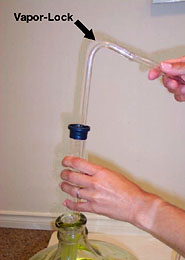 When I do my first racking, there is a lot of carbonation in the wine, and it does not siphon well at all. How should I handle this?
When I do my first racking, there is a lot of carbonation in the wine, and it does not siphon well at all. How should I handle this?
Name: Bryan P.
State: GA
Hello Bryan,
Yes, this can be quite a problem. For the readers out there who don’ t understand what Bryan is talking about, let me explain a little bit.
During a fermentation, CO2 gas is created by the wine yeast. This is the same stuff that creates the fizzy in beer and soda pop. This CO2 gas is saturated into the wine must.
When Bryan is racking [siphoning] his wine must from his primary fermenter to his secondary fermenter, the gas starts to release from the liquid within the siphon hose. This is because the liquid is being agitated, much like shaking a bottle of soda pop. The gas collects and rises to the highest point of the siphon hose and forms a gas pocket, which eventually breaks off the siphon and stops the flow of the liquid. This is known as a vapor-lock.
One thing I have done in the past, is raise the exit-end of the siphon hose as high as I can to get the gas pocket to rise and release out the end of the hose and then start the siphon again, but this is a very annoying process and may be required more than once during a 5 gallon racking. It is also very hard to do if you are employing a curved racking cane in the siphon process. The rigid curve in the racking cane requires you to turn the cane completely upside-down to get the gas to release.
Siphoning without a racking cane is no good either. This is because a loose hose in the bottom of a fermenter will do nothing but sabotage your racking efforts by stirring up the sediment that has collected at the bottom. The rigid tube of the racking cane allows you to keep the end of the siphon under control a not sloshing all around, sort of like a wand.
The only way I’ve been able to get completely around the vapor-lock issue is to use fermenters that have spigots at the bottom. You attach the siphon hose directly onto the spigot . Then you can depend completely on gravity to start the flow. By siphoning in this way there is no opportunity for a CO2 gas pocket to develop. There is no rising curve coming up and out of the top of the fermenter as with a regular siphon.
All the primary fermenters we offer have spigots at the bottom that will accept a 3/8″ I.D. vinyl siphon hose. The spigots are strategically placed away from the bottom so that sediment will not be drawn. As you get towards the end of the siphon, gently tilt the fermenter towards the faucet-side to round up the last bit of liquid.
Last year we also introduced secondary fermenters that have the same faucet at the bottom. They are plastic carboys of varying sizes: 3, 5 and 6 gallon. They are all made out of the same exact plastic that is used to 2 liter soda pop bottles, only thicker.
By using these types of fermenters you can avoid the vapor-lock issue all together. Also, you are not sticking anything into the fermenter that can potentially stir up the sediment. The sediment stays at the bottom quiet and undisturbed through the entire racking.
Happy Winemaking,
Ed Kraus
———————————————————————————————————
Ed Kraus is a 3rd generation home brewer/winemaker and has been an owner of E. C. Kraus since 1999. He has been helping individuals make better wine and beer for over 25 years.
